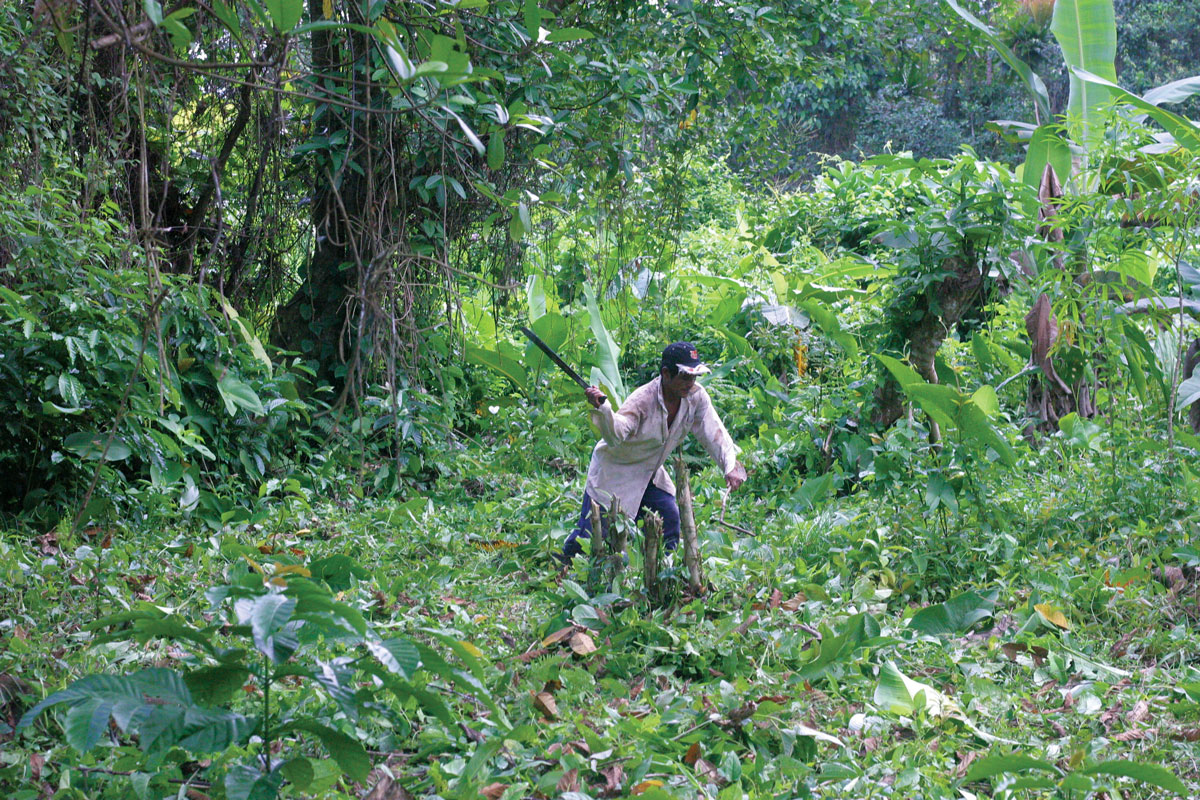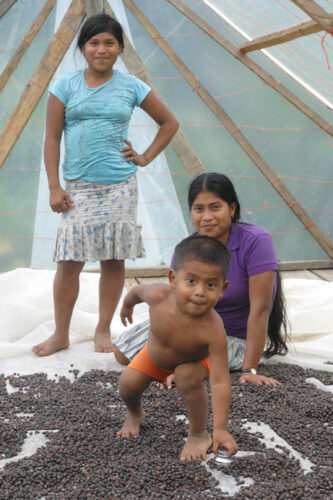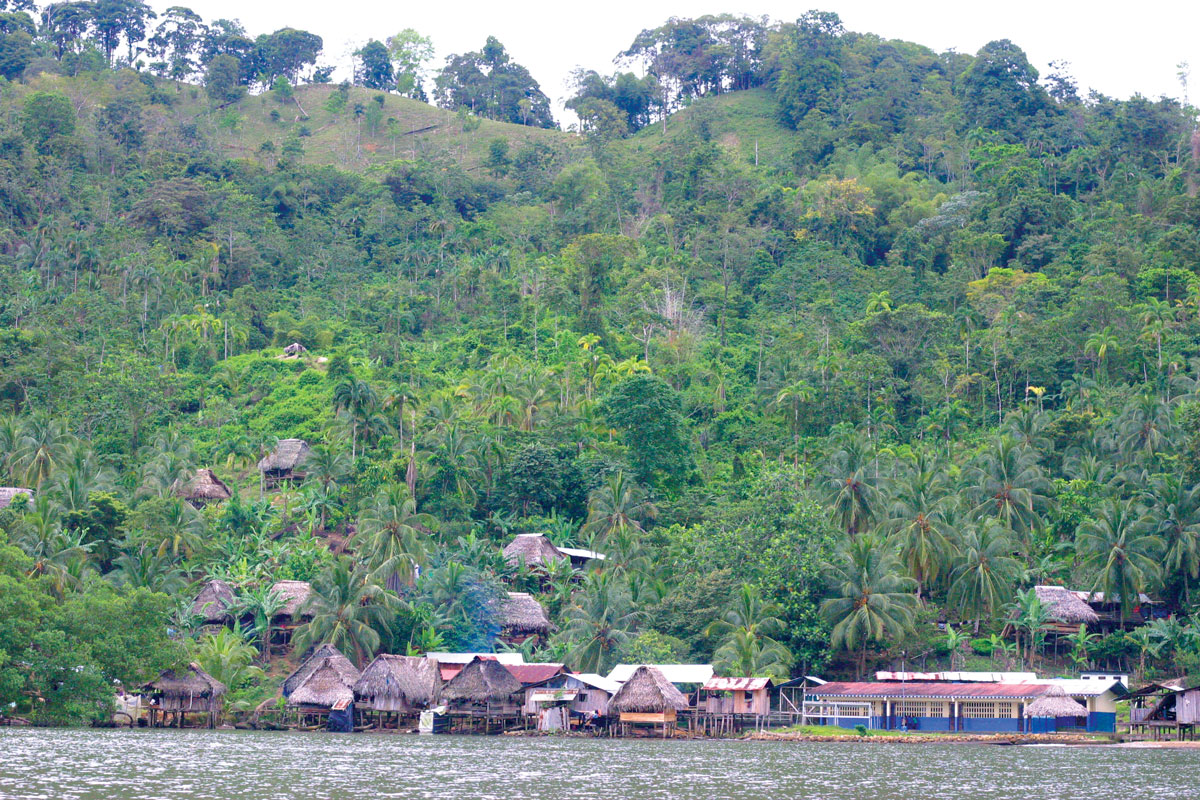[F]ederico Palacios lives in the village of Bahia Ballena on Panama’s Caribbean coast, but before considering himself Panamanian, he would identify as Ngöbe, one of Panama’s seven indigenous groups. His home in Ballena is within the borders of the Ngöbe-Buglé Comarca, a large area belonging to the Ngöbe and Buglé peoples. He owns the land on which his palm-thatch-roofed stilt house stands, and he owns a finca, a larger piece of property deep within the mangroves, where his wife and daughters grow root vegetables like ñampí and ñamé and where he grows Robusta coffee.
More on the Ngöbe and coffee laborers. A conversation with author Rachel Northrop.
The folds around Federico’s smile are deeply creased, and a faded baseball cap is pulled snugly over his jet-black hair. In Ballena, Federico is known for his work ethic, one of those model citizens who is already in the canoe he carved himself, paddling to his finca before the sun comes up. He paddles with effortless fluidity, balances barefoot on mud-slick slopes carrying hundred-pound palm leaf bales on his shoulders, and he wields a machete mercilessly, affording no weed or vine a second chance. Even standing still his compact form reveals a strength formed by a lifetime of physical labor. He attends every coffee co-op meeting (even after the former president disappeared with the sum of last year’s members’ dues). He’s not petty enough to complain that the communal raised “solar dryer” beds are on the other side of town from his house, and he is respected for his diplomacy, being one of the first people to shake hands with me when I showed up on Ballena’s shores.
Federico is a farmer but also a seasonal coffee picker. For most of his life he has spent the summer harvest months in the Rio Sereno and Renacimiento areas near the Costa Rican border or on farms in Costa Rica’s Tarrazú and Pérez Zeledón regions, picking coffee on large estates. He is one of thousands of Ngöbes living a duality of coffee that is uniquely Panamanian, working as an indispensable seasonal worker while also cultivating coffee on his own land.
In Panama, the coffee harvest is synonymous with the brightly patterned attire of Ngöbe men, women, and children as thousands of families take to Panama’s verdant mountains to harvest every single one of the country’s ripe coffee cherries by hand. As is true at most coffee origins, steep and rugged terrain make mechanical harvesting impossible and demand hand-picking by workers practiced in the art of sure-footed precision.
Ngöbe families are a crucial part of Panama’s social and economic fabric, but the majority of the year, when they aren’t visibly working as coffee harvesters.
No two producing countries have the same systems for growing, processing, and commercializing coffee, and yet Panama still stands out. The nation of 3.4 million, with a land area roughly the size of South Carolina, differentiates itself not only in its topography and weather, which yield microclimates responsible for some of the world’s most sought after coffee beans, but for its distribution of land ownership. Panama’s seven indigenous groups own land in five comarcas, roughly equivalent to reservations in the United States. The largest, the Ngöbe-Buglé Comarca, constitutes the country’s fourth largest province, stretching from the northern Caribbean coast to the Pan-American Highway in the south.

In spite of its size, the interior of the comarca is sight unseen to most Panamanians and visitors. Many Ngöbe families trek to Panama and Costa Rica’s coffee zones to spend the summer working as harvesters on midsized or large estates. Ngöbe families are a crucial part of Panama’s social and economic fabric, but the majority of the year, when they aren’t visibly working as coffee harvesters, their lives are as much of a mystery to most Panamanians as they are to foreigners.
The town of Boquete, one of Panama’s main coffee growing regions and of recent Gesha-growing celebrity, is located at the “dead end” of the base of the Barú Volcano. Roads have nowhere else to go and consequently loop around the lush jungles at the foothills of the volcano, exposing views of valleys planted with various vegetable and coffee crops. Also clearly visible from the roads’ jarring curves are the modest row houses where Ngöbe seasonal workers live during the harvest. Boquete draws many coffee buyers intent on sourcing the next rare gem, but it attracts many more tourists keen on bird watching and hiking. After passing a block of workers’ quarters on a hike, I overheard one tourist couple go so far as to say, “The way these people are forced to live—it’s like slavery!”
Seeing simple cement buildings and a row of cooking fires sheltered by skewed tin roofs may be interpreted as a gross injustice, but the real injustice would be arriving at such a loaded conclusion while only seeing a sliver of the big picture.
The comarcas are not quite Panamanian soil, and to enter you need a reason and a host, meaning few non-indigenous people have the opportunity to enter the Ngöbe-Buglé Comarca. The comarcas belonging to the Kuna Yala include islands with white-sand beaches and therefore have been opened up to restricted tourism operations managed by Comarca residents, but though the large Ngöbe-Bugle Comarca includes a broad diversity of terrain, none of it is the type enticing to visitors.
Peace Corps Panama has an active presence in Panama’s indigenous communities, and I was invited to visit two Peace Corps sites in the Comarca as part of the research for my book When Coffee Speaks. Peace Corps volunteer Matt Tansey was assigned to a site in Bahia Ballena to help train coffee farmers in sustainable production methods.

Ballena is only accessible by boat from the coastal town of Chiriquí Grande, and as Matt and I approached, in a wooden canoe outfitted with a small outboard motor, I could see the stilted, palm-roofed houses clustered on the shore in the distance, with the vertical, rippling jungle mountains rising up behind the buildings. I kept my query, “But where’s the coffee?” to myself.
Ballena was desperate for a cash crop, so they planted Robusta coffee, but without any traditional knowledge of coffee growing, training, or real planning.
Matt explained that “Ballena was a fishing community until an oil spill in the bay about ten years ago eliminated that as a source of income—and food. Ballena was desperate for a cash crop, so they planted Robusta coffee, but without any traditional knowledge of coffee growing, training, or real planning.” Ballena community members like Federico have tucked coffee plots into whatever land they have, sometimes a mile straight up the mountain in the middle of virgin jungle, sometimes along the winding channels deep in the mangroves.
Practices standard in most coffee production, like pruning cycles and regular fertilizations, are largely nonexistent in Ballena. Amending that is a difficult process, with attempts at forming a co-op being stymied by corruption and petty disputes and with members absent for months at a time, either for coffee harvests or to visit family in other places. (Ngöbes are polygamous and it is common for a man to travel between the villages where his wives and children live.) All this is further complicated by the extremity of the environment: no vehicles, no roads; just paths best traversed barefoot and dizzying mazes of mangrove roots. Coffee growers in Ballena haul their harvests down the mountain—sometimes even paddling their coffee miles to Chiriquí Grande—to sell to middlemen.
Food security, health and sanitation, and education are always pressing issues in the comarca, due mostly to the historically complicated and distrustful relations between residents of the comarca and Panamanian public service institutions. But, the invaluable silver lining is that comarca residents own their land. In most other Latin American nations, seasonal workers do not own any land and rely entirely on income earned during the harvest in order to survive for the year. While many harvesters must search for work in cities during the off-season, Ngöbe harvesters are able to return to their own homes and farms. Even if they aren’t producing microlot specialty coffee, they can grow their own food and have a home to fall back on, a freedom not publicized by the modest accommodations in which they spend a few months a year if they elect to earn some income as coffee harvesters.
Because these coffee pickers are not tied by homes or families to the farms where they work, the demands of the workforce shape labor realities. If a family is unhappy with the conditions on one farm, they simply pick up and go to another. How an estate factors in the cost of accommodations into workers’ wages varies, but if an employee doesn’t like the arrangement he is free to leave. Workers’ quarters might seem rudimentary to outside eyes, but to workers Boquete is the best place in Panama to pick coffee, with harvesters earning higher than average wages to carefully collect the country’s most prized beans.
Because these coffee pickers are not tied by homes or families to the farms where they work, the demands of the workforce shape labor realities.
Harvesters are paid per unit of ripe cherries picked (usually by the pound; paying per volumetric unit was discontinued after a plague of coffee berry borer—la broca—swept the country a few years back, skewing the volume-to-weight ratio). The price pickers earn per pound is directly derived from the New York “C” market price and additionally fluctuates with the cycle of the harvest; the price goes up at the beginning and end of the harvest when there are fewer cherries on the trees and a pound requires more effort to pick.
Panama has the odd advantage of using US dollars and not being exposed to the added volatility of currency exchange rates, and the premiums buyers pay for specialty coffee allow farms to extend higher payouts to their workforces. No farms in Panama are large in comparison to sprawling estates in other producing countries for which coffee is a more crucial export crop, but farms are large enough that they require lots of hands to pick cherries at their prime.
Securing this workforce can be a challenge. “It’s certain that we’ve paid better salaries and many farms have improved their facilities to include better houses for their workers, but the lack of workers is evident in many farms,” says Ricardo Koyner, owner of Kotowa Coffee, an integrated company with fincas around Boquete and a coffeehouse chain throughout Panama. “Other industries like construction, restaurants, and tourism are demanding more employees, which makes it harder to attract people to the fields. The only way to have people to pick coffee is to pay people much higher salaries so that the job becomes attractive.”
Because of the positive reputation Boquete coffee has earned in international specialty markets, thus bringing higher prices per pound all the way back to pickers, the same families return to Boquete harvest after harvest. Melissa Anyka, who helps manage a long-running farm in Boquete notes, “I’ve seen kids who were born here and are now working. And the elderly who spend the days with their families. This shows that this is a good place to work, or they would not have stayed for so many generations.”
Not all Ngöbe finca employees are seasonal; some work in coffee year round. At Boquete’s Finca Elida, Felipe works as the farm manager. “I do everything—germinating, filling the bags, transplanting seedlings, planting, everything! I’ve been here for eight years and in charge of the processing for five.” Felipe moved to Boquete from Tolé, a town in the comarca where I visited a second Peace Corps site.
There, in the dry, windswept mountain village of Majagua, Federico de Tolé and his community have planted a few Typica trees at just 700 meters, 2,300 feet, above sea level. “Before, we didn’t know what coffee was. But, from time spent in other places, people were buying coffee [to drink]. We thought it might be easier if we grew our own plants,” he says. Federico de Tolé is eager to learn, paying close attention to the Peace Corps workshop as he prepares to prune his coffee for the first time in the twenty years he’s been cultivating the trees.
Federico Palacio’s natural processed, mangrove-grown Robusta and Federico de Tolé’s low-growing Typica for home consumption might never compare with the prized auction lots Felipe manages in Boquete, but there is a connection between the poles of Panama’s super-specialty coffee coming from the most ideal microclimates and the coffee being cultivated in the challenging comarca environments.
Panamanian coffee would not be possible without the work of Ngöbe harvesters, and the more successful mainstream Panamanian coffee production becomes, the more Ngöbe families can invest their increased earnings back into sustainable agriculture—be it food crops or coffee production—on their own land, properties tucked in corners of the country that are no less full of potential for being removed from the visible and beaten path.
—Rachl Northrop is a writer based in New York City.



















